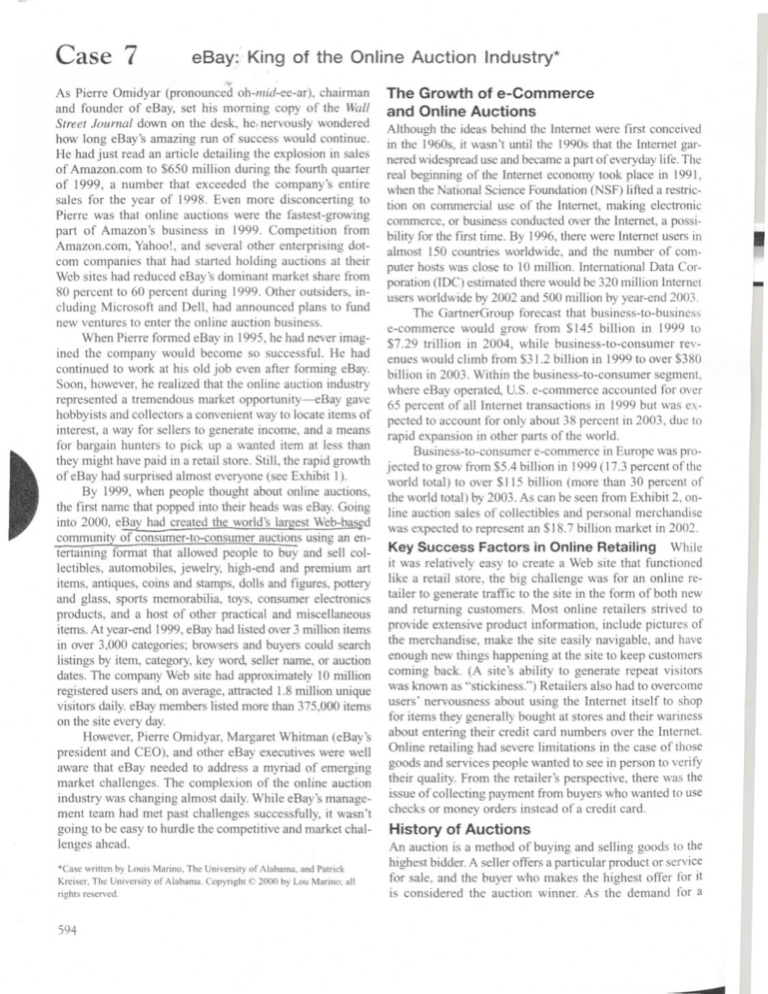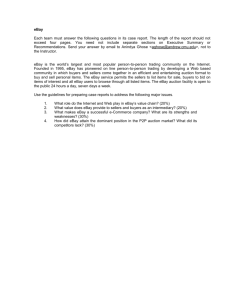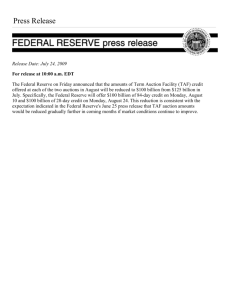
Case 7
eBay: King of the Online Auction Industry*
As Pierre Omidyar (pronounced oh-mid-ee-ar), chairman
and founder of eBay, set his morning copy of the Wall
Street Journal down on the desk, he. nervously wondered
how long eBay's amazing run of success would continue.
He had just read an article detailing the explosion in sales
of Amazon.com to $650 million during the fourth quarter
of 1999, a number that exceeded the company's entire
sales for the year of 1998. Even more disconcerting to
Pierre was that online auctions were the fastest-growing
part of Amazon's business in 1999. Competition from
Amazon.com, Yahoo!, and several other enterprising dotcom companies that had started holding auctions at their
Web sites had reduced eBay's dominant market share from
80 percent to 60 percent during 1999. Other outsiders, including Microsoft and DelI, had announced plans to fund
new ventures to enter the online auction business.
When Pierre formed eBay in 1995, he had never imagined the company would become so successful. He had
continued to work at his old job even after forming eBay.
Soon, however, he realized that the online auction industry
represented a tremendous market opportunity-eBay gave
hobbyists and collectors a convenient way to locate items of
interest, a way for sellers to generate income, and a means
for bargain hunters to pick up a wanted item at less than
they might have paid in a retail store. Still, the rapid growth
of eBay had surprised almost everyone (see Exhibit 1).
By 1999, when people thought about online auctions,
the first name that popped into their heads was eBay. Going
into 2000, eBay had created the world's largest Web-based
community of consumer-to-consumer auctions using an entertaining format that allowed people to buy and sell collectibles, automobiles, jewelry, high-end and premium art
items, antiques, coins and stamps, dolls and figures, pottery
and glass, sports memorabilia, toys, consumer electronics
products, and a host of other practical and miscellaneous
items. At year-end 1999,eBay had listed over 3 million items
in over 3,000 categories; browsers and buyers could search
listings by item, category, key word, seller name, or auction
dates. The company Web site had approximately 10 million
registered users and, on average, attracted 1.8 million unique
visitors daily. eBay members listed more than 375,000 items
on the site every day.
However, Pierre Omidyar, Margaret Whitman (eBay's
president and CEO), and other eBay executives were welI
aware that eBay needed to address a myriad of emerging
market chalIenges. The complexion of the online auction
industry was changing almost daily. While eBay's management team had met past challenges successfully, it wasn't
going to be easy to hurdle the competitive and market challenges ahead.
'Case written by Louis Marino, The University of Alabama. and Patrick
Kreiser. The University of Alabama. Copyright fi:!2000 by Lou Marino; all
rights reserved.
The Growth of e-Commerce
and Online Auctions
Although the ideas behind the Internet were first conceived
in the I960s, it wasn't until the I990s that the Internet garnered widespread use and became a part of everyday life.The
real beginning of the Internet economy took place in 199I,
when the National Science Foundation (NSF) lifted a restriction on commercial use of the Internet, making electronic
commerce, or business conducted over the Internet, a possibilityfor the first time.By 1996,therewereInternetusers in
almost 150 countries worldwide, and the number of computer hosts was close to 10 million. International Data Corporation (IDC) estimated there would be 320 million Internet
users worldwide by 2002 and 500 million by year-end 2003.
The GartnerGroup forecast that business-to-business
e-commerce would grow from $145 billion in 1999 to
$7.29 trillion in 2004, while business-to-consumer revenues would climb from $31.2 billion in 1999 to over $380
bilIion in 2003. Within the business-to-consumer segment,
where eBay operated, U.S. e-commerce accounted for over
65 percent of all Internet transactions in 1999 but was expected to account for only about 38 percent in 2003, due to
rapid expansion in other parts of the world.
Business-to-consumer e-commerce in Europe was projected to grow from $5.4 bilIion in 1999 (I 7.3 percent of the
world total) to over $1 15 billion (more than 30 percent of
the world total) by 2003. As can be seen from Exhibit 2, online auction sales of colIectibles and personal merchandise
was expected to represent an $18.7 billion market in 2002.
~
-
Key Success Factors in Online Retailing While
it was relatively easy to create a Web site that functioned
like a retail store, the big chalIenge was for an online retailer to generate traffic to the site in the form of both new
and returning customers. Most online retailers strived to
provide extensive product information, include pictures of
the merchandise, make the site easily navigable, and have
enough new things happening at the site to keep customers
coming back. (A site's ability to generate repeat visitors
was known as "stickiness.") Retailers also had to overcome
users' nervousness about using the Internet itself to shop
for items they generalIy bought at stores and their wariness
about entering their credit card numbers over the Internet.
Online retailing had severe limitations in the case of those
goods and services people wanted to see in person to verify
their quality. From the retailer's perspective, there was the
issue of colIecting payment from buyers who wanted to use
checks or money orders instead of a credit card.
History of Auctions
An auction is a method of buying and selling goods to the
highest bidder. A seIler offers a particular product or service
for sale, and the buyer who makes the highest offer for it
is considered the auction winner. As the demand for a
594
...
595
Case 7 eBay: King of the Online Auction Industry
Exhibit1
Selected Indicators of eBay's Growth, 1996-99
Numberofregisteredusers
Grossmerchandisesales
Numberof auctionslisted
1996
1997
1998
1999
41,000
$7million
341,000
$95million
2.181,000
$745million
10,006,000
$2.8billion
289,000
4,394,000
33,668,000
129,560,000
biiibit2
Estimated Growth in Global e-Commerce and Online Auction Sales, 1999-2004
~
:Estimated
business-to
Dusinesssales
1999
2000
2001
2002
2003
2004
$145billion
$403billion
$953billion
$2.18trillion
$3.95trillion
$7.29trillion
Source:GartnerGroup.
Online Auction Sales of Collectibles and Personal Merchandise
(Sales
$20
-
rJI
c:
"E
8
Estimated Growth in Global
Business-to-Business e-Commerce
6
$18.7
en
c: $15
~
:c
g $10
UJ
CD
Iii
en
4
.
in billions of dollars)
$5
2
0
$0
1999 2000
2001
2002
2003
2004
$0.00 $0.026 $0.131
1995
1996
1997
$0.754
r..
1998 1999
I
I I
I I
I
2000 2001 2002
Source:Keenan Vision Inc. Mercury' News.
particulargood rises among the buyers (typically due to its
scarcityor desirability), the price also rises. Competition
.amongbidders for a desirable good drives up the price.
:Sometimesthe highest bid will exceed the generally ac.ctaJted
market value of the good, a phenomenon known as
the "winner'scurse." In this situation, the buyer becomes
soemotionally
attachedto the good or to placingthe highestbidthathe or she ends up bidding more than the good
wouldcost in a nonauction setting.
Thefirst known auctions were held in Babylon around
500BC.In these auctions women were sold to the highest
1Jidder.on
the condition th;t they marry the auction winner.
~ancient Rome, soldiers
-
would auction the spoils of their
~tories and wealthy citizens would auction their expenSlV~belongings and prized possessions. In 193 AD, the
'entireRoman Empire was put up for auction after the
eJnperorPertinax was executed. Didius Julianus bid 6,250
drachmas per royal guard and was immediately named
emperor of Rome. However, Julianus was executed only
two months later, indicating that he may have been the
first-ever victim of the winner's curse.
Since that time, auctions have been conducted in every
comer of the globe. The possessions of deceased Buddhist
monks were auctioned off as early as the seventh century. In
the late 16th century, auctions began to be held in taverns
and alehouses in Great Britain. Sotheby's was founded in
1744, and Christie's was established in ]766; both have now
become world-renowned auction houses for rare and valuable items. Auctions for tobacco, horses, and other domestic animals were commonplace in colonial America.
Auctions have endured throughout history for several
reasons. First, they give sellers a convenient way to find
a buyer for something they would like to dispose of.
Second, auctions are an excellent way for people to collect
596
\.,;asEo7
eBay: King of the Online Auction Industry
difficult-to-find items, such as Beanie Babies or historical
memorabilia, that have a high value to them personally.
Finally, auctions are one of the "purest" markets that exist for
goods. in that they bring buyers and sellers into contact to arrive at a mutually agreeable price. Experts estimated that the
national market for auctions, garage sales, flea markets, and
classified purchases was greater than $100 billion in 1999.
Online Auctions
Online auctions worked in essentially the same way as traditional auctions, the difference being that the auction
process occurred over the Internet rather than at a specific
geographic location with buyers and sellers physically present. In 2000, there were three categories of online auctions:
1.
2.
3.
Business-to-business auctions, which accounted for
$2.5 billion in sales in 1998 and involved such items as
computers, used equipment, and surplus merchandise.
Business-to-consumer auctions, in which businesses
sold goods and services to consumers via the
Internet. Many such auctions involved companies
interested in selling used or discontinued goods, or
liquidating unwanted inventory.
Person-to-person auctions, which gave interested
sellers and buyers the opportunity to engage in competitive bidding.
Since eBay's pioneering of the person-to-person online
auction process in 1995,the number of online auction sites on
the Internet had grown to well over 1,600 by the end of 1999.
Forrester Research predicted that 6.5 million customers
would use online auctions in 2002. In 1999 an estimated 8.2
percent ofInternet users had registered at an auction site; the
percentage was expected to be 14.5 percent by 2002.
Online auction operators could generate revenue in
four principal ways:
1.
2.
3.
4.
Charging sellers for listing their good or service.
Charging a commission on all sales.
Selling advertising on their Web sites.
Selling their own new or used merchandise via the
online auction format.
Most sites charged sellers either a fee or a commission
and sold advertising to companies interested in promoting
their goods or services to users of the auction site.
Auction Software Packages
In 1996. OpenSite
Technologies began to offer packaged software applications
to firms interested in creating their own online auction Web
sites. Moai Technologies and Ariba, Inc., were other sources
for auction software. The ready availability of commercial
software packages made it easy for firms to create and operate online auction sites. OpenSite had marketed over 600
auction packages to such companies as The Sharper Image, CNET, and John Deere. OpenSite claimed that its
purpose was to bring together "buyers and sellers, helping
businesses dynamically manage inventory, create sales
channels, attract customers, and test-market new products,
to create efficient markets for goods and services."
Providers of Site Hosting
Auction Services
and Online
Auction firms could, if they wished, outsource all the hosting functions associated with online auctions to independent site-hosting enterprises and could even turn the entire
auction process over to an independent online auction specialist. FairMarket, the leader in auction outsourcing in
1999, provided companies such as ZDNet, MicroWarehouse, and CollegeBytes.com with a means of selling their
goods at online auction at Fair-Market's Web site. The use
of site hosts and independent online auction services was a
particularly appealing option for companies that wanted to
use online auctions as a distribution channel but preferred
to devote only minimal time and energy to site construction
and upkeep. By paying FairMarket an annual hosting fee
between $2,000 and $10,000, as well as a percentage fee on
all transactions, firms were able to have an auction site
without having to worry about the hassle of site upkeep.
Online Auction Users Participants in online auctions could be grouped into three categories: (I) bargain
hunters, (2) hobbyists/collectors, and (3) sellers.
Bargain Hunters
Bargain hunters viewed online auctions primarily as a form of entertainment: their objective
usually was to find a great deal. One bargain hunter described the eBay experience as follows:
A friend and I would spend one day a week going flea
marketing and auctioning. Since school has started again,
time has become a hot commodity. We've found that we
can use eBay to fill that flea marketing, auctioning need.
We'll call each other, then get on eBay and hunt and find
things togethereventhough we can't be together.EBay has
definitely been a great wayto spend quality time together!
Bargain hunters were thought to make up only 8 percent
of active online users but 52 percent of eBay visitors. To attract repeat visits from bargain hunters. industry observers
said, sites must appeal to them on both rational and emotional levels, satisfying their need for competitive pricing,
the excitement of the search, and the desire for community. I
Hobbyists and Collectors
Hobbyists and collectors
used auctions to search for specific goods that had a high
value to them personally. They were very concerned with
both price and quality. Collectors prized eBay for its wide
variety of product offerings. One user commented:
My sister collects Princess House hand-blown ornaments. She needed the first three to complete her series. I posted to the Wanted Board several times, and
also put a note on my About Me page. Well, we have
now successfully completed her series. We could never
have done this without eBay because the first one is so
hard to find. Thanks eBay!
Case /'
eBay: King of the Online Auction Industry
Sellers Those in the sellers category could be further
differentiated into at least three types: casual sellers, hobbyists/collectors, and power sellers. Casual sellers included individuals who used eBay as a substitute for a
classified ad listing or a garage sale to dispose of items
they no longer wanted. While many casual sellers listed
only a few items, some used eBay to raise money for some
new project. One such seller stated:
Thank you! After just starting to use your site less than a
month ago, I have increased my earnings by over $1,000.
I have not yet received all the cash, but so far the response
has been fantastic. This all started with a Kool-Aid container and four cups I had that were collecting dust in a
box in the attic. I was "browsing for bargains" and saw
someone else had made $29.00 from those plastic things!
I was AMAZED! Needless to say, I listed them. I only
made $8.00, but I received my first positive feedback.
Since then I am listing daily.
My wife and I are scrimping to save for an adoption
of a baby. The fees are much more than our modest income can afford and this extra cash will come in handy.
My wife and I sincerely thank you and your company for
the opportunity to be a part of eBay.
Sellers who were hobbyists or collectors typically
dealt in a limited category of goods and looked to eBay as
a way to sell selected items in their collections to others
who might want them. Power sellers were typically smallto medium-sized businesses that favored eBay as a primary distribution channel for their goods and often sold
tens of thousands of dollars' worth of goods every month
on the site. One estimate suggested that while these
power sellers accounted for only 4 percent of eBay's population, they were responsible for 80 percent of eBay's
total business.2
Concerns
about
Buyer Addiction
to Online
Auctions Some members of the online auction community reportedly found the experience so intriguing that
they became addicted. According to the Center for Online
Addiction, symptoms of online auction addiction ranged
from "using online auctions as a way of escaping from
problems or relieving feelings of helplessness, guilt, anxiety, or depression" to "needing to bid with increasing
amounts of money in order to achieve the desired excitement.,,3 The center predicted that "online auction houses
will be the next frenzy leading to shopping addiction" and
had treated online auction addicts who had to take out a
second mortgage or file bankruptcy as a result of their excessive online purchases.4 One online auction addict told
of his experience as follows:
w
It became critical when my boss confronted me. [My employer] had monitored my Internet use, and it was even
more than I was aware of. My boss told me he had no
choice but to terminate me. I've been at this job almost
597
five years, have achieved recognition at the national level
for the program, and have previously been a very capable
employee. How can I [justify] throwing all that away?
There is no doubt, though, that my productivity had really
begun to suffer.
I was truthful with my boss about how this had become a compulsion I just could not control. I attributed it
to some real stresses in my personal life, and kept telling
myself that when things settled down, I would get a handle on it. He has put me on [administrative] leave while
he thinks things over.5
Pierre Omidyar and the Founding of eBay
Pierre Omidyar was born in Paris, France, to parents who
had left Iran decades earlier. The family emigrated to the
United States when Pierre's father began a residency at
Johns Hopkins University Medical Center. Pierre grew up
in modest circumstances; his parents divorced when he was
two but remained near each other so he could be with both
of them. Pierre's passion for computers began at an early
age; he would sneak out of gym class in high school to play
with computers. While still in high school, at age 14 he
took his first computer-related job in the school's library,
where he was hired for $6.00 an hour to write a program to
print catalog cards.6 After high school Pierre attended Tufts
University, where he met his future wife, Pamela Wesley,
who came to Tufts from Hawaii to get a degree in biology.
Upon graduating in 1988, the couple moved to California,
where Pierre, who had earned a BS in computer science,
joined Claris, an Apple Computer subsidiary in Silicon
Valley, and wrote a widely used graphics application,
MacDraw. In 1991, Omidyar left Claris and cofounded Ink
Development (later renamed eShop), which became a
pioneer in online shopping and was eventually sold to
Microsoft in 1996. In 1994 Omidyar joined General Magic
as a developer services engineer and remained there until
mid-1996, when he left to pursue full-time development
of eBay.
Internet folklore has it that eBay was founded solely
to allow Pamela to trade Pez dispensers with other collectors. While Pamela was certainly a driving force in
launching the initial Web site, Pierre had long been interested in how one could establish a marketplace to bring
together a fragmented market. Pierre saw eBay as a way
to create a person-to-person trading community based on
a democratized, efficient market where everyone could
have equal access through the same medium, the Internet.
Pierre set out to develop his marketplace and to meet both
his and Pamela's goals. In 1995 he launched the first online auction under the name of Auctionwatch at the domain name of www.eBay.com. The name eBay stood for
"electronic Bay area," coined because Pierre's initial concept was to attract neighbors and other interested San
Francisco Bay area residents to the site to buy and sell
items of mutual interest. The first auctions charged
no fees to either buyers or sellers and contained mostly
598
~ ~~e
Exhibit 3
-
eBay: King of the Online Auction Industry
eBay's Income Statements. 1996-99 ($000. Except Pcr Sharc Figures)
1996
Net revenues
Costof net revenues
Grossprofit
Operatingexpenses
Salesand marketing
Productdevelopment
Generaland administrative
Amortizationof acquiredintangibles
Merger relatedcosts
Totaloperatingexpenses
Income(loss)from operations
Interestand other income(expense),net
Incomebeforeincometaxes
Provisionfor incometaxes
Net income
Net incomeper share
Basic
Diluted
Weightedaverageshares
Basic
Diluted
1997
1998
1999
$32,051
6,803
$41,370
8,404
$86,129
16,094
$224,724
57,588
25,248
32,966
70,035
167;136
13,139
28
5,661
15,618
831
6,534
35,976
4,640
15,849
805
95,956
23,785
43,055
1,145
4,359
18,828
22,983
57,270
168,300
6,420
(2,607)
3,813
I
9,983
)
8,032
-IW)
12.765
)
12,062
(4,789)
$ 7,273
(1,164)
21,377
20,213
(9,385)
$ 3,338
$ 7,061
$0.39
.07
$0.29
0.08
$0.14
0.06
$0.10
0.08
8,490
45,060
24,428
84,775
52,064
116,759
108,235
135,910
$ 10,828
Source: Company financial documents.
computer equipment (and no Pez dispensers). Pierre's
fledgling venture generated $1,000 in revenue the first
month and an additional $2,000 the second. Traffic grew
rapidly, however, as word about the site spread in the Bay
area: a community of collectors emerged, using the site to
trade and chat-some marriages resulted from exchanges
in eBay chat rooms.7
By February 1996, the traffic at Pierre Omidyar's site
had grown so much that his Internet service provider informed him that he would have to upgrade his service.
When Pierre compensated for this by charging a listing fee
for the auction, and saw no decrease in the number of items
listed, he knew he was on to something. Although he was
still working out of his home, Pierre began looking for a
partner and in May asked his friend Jeffrey Skoll to join
him in the venture. While Jeffhad never cared much about
money, his Stanford MBA degree provided the firm with
the business background that Pierre lacked.x With Pierre as
the visionary and Jeff as the strategist, the company
embarked on a mission to "help people tr:olrlpFracti~lIy
IDlY
thing o~h."
Their concept for eBay was to "create a
place where people could do business just like in the old
days-when everyone got to know each other personallv,
and we all felt we were dealing on a one-to-one basis wi]h
irnIividuals we could tru~t."
In eBay's early days, Pierre and Jeff ran the operation
alone, using a single computer to serve all of the pages.
Pierre served as CEO, chief financial officer, and president, while Jeff functioned as co-president and director. It
was not long until Pierre and Jeff grew the company to a
size that forced them to move out of Pierre's living room,
due to the objections of Pamela, and into Jeff's living
room. Shortly thereafter, the operations moved into the facilities ofa Silicon Valley business incubator for a time until the company settled in its current facilities in San Jose,
California.
Exhibits 3 and 4 present eBay's recent financial
statements.
Case
Exhibit 4
599
eBay: King of the Online Auction Industry
eBay's Consolidated Balance Sheets, 1997-99 ($000)
December31.
1997
December31.
1998
December31.
1999
$3,723
1,024
220
$ 37,285
40,401
12.425
7.479
$219,679
181,086
36.538
22,531
4,967
652
97,590
459,834
44,062
7,884
111,806
373,988
5,639
12,675
$5,619
$149,536
$963,942
$252
$ 9,997
6,577
973
4,047
1,380
1,682
5,981
$ 31,538
32,550
5,997
12,285
6.455
1,124
305
157
24,656
88,825
18,361
-
15,018
1,586
48,998
111.475
3,018
1,015
100,538
852.467
$5,619
$149,536
$963,942
Assets
Current assets
Cash and cash equivalents
Short-term investments
Accounts receivable, net
Other current assets
Total current assets
Property and equipment, net
Investments
Deferred tax asset
Intangible and other assets, net
Total assets
Liabilities and Stockholders'Equity
Current liabilities
Accounts payable
Accrued expenses and other current liabilities
Deferred revenue and customer advances
Debt and leases, current portion
Income taxes payable
Deferred tax liabilities
Other current liabilities
Total current liabilities
Debt and leases, long-term portion
Other liabilities
Total liabilities
Series B mandatorily redeemable convertible
preferred stock and Series B warrants
Total stockholders' equity
Total liabilities and stockholders' equity
128
258
169
128
7,632
-
Source: Company financial documents.
eBay's Transition
to Professional Management
....
..
From the beginning Pierre Omidyar intended to hire a
professional manager to serve as the president of eBay:
"[I would] let him or her run the company so . . . [I could]
go play.,,9 In 1997 both Omidyar and Skoll agreed that it
was time to locate an experienced professional to function
as CEO and president. In late 1997 eBay's headhunters
came up with a candidate for the job: Margaret Whitman,
then general manager for Hasbro Inc.'s preschool division.
Whitman had received her BA in economics from Princeton
and her MBA from the Harvard Business School; her first
job was in brand management at Procter & Gamble. Her experience also included serving as the president and CEO of
FTD, the president of Stride Rite Corporation's Stride Rite
Division, and as the senior vice president of marketing for
the Walt Disney Company's consumer product division. 10
When first approached by eBay, Whitman was not
especially interested in joining a company that had fewer
than 40 employees and less than $6 million in revenues the
600
Case 7 eBay: King of the Online Auction Industry
previous year. It was only after repeated pleas that
Whitman agreed to meet with Omidyar in Silicon Valley.
After a second meeting, Whitman realized the company's
enormous growth potential and agreed to give eBay a try.
According to Omidyar, Meg Whitman's experience in
global marketing with Hasbro's Teletubbies, Playskool, and
Mr. Potato Head brands made her "the ideal choice to build
upon eBay's leadership position in the one-to-one online
trading market without sacrificing the quality and personal
touch our users have grown to expect."ll In addition to
convincing Margaret Whitman to head eBay's operations,
Omidyar had been instrumental in helping bring in other
talented senior executives and in assembling a capable
board of directors. Notable members of eBay's board of directors included Scott Cook, the founder of Intuit, a highly
successful financial software company, and Howard
Schultz, the founder and CEO of Starbucks. (For a profile
of eBay's senior management team, check out the Company Overview section at www.ebay.com.)
Whitman ran the operation from the time she came on
board. Omidyar, who owned 27.9 percent of eBay's stock
(worth approximately $6 billion as of March 2000), spent
considerable time in Paris. He and Pamela, still in their
mid-30s and concerned about the vast wealth they had accumulated in such a short period of time, were devoting a substantial amount of their energy to exploring philanthropic
causes. 12They had decided to give most of their fortune to
charity and were scrutinizing alternative ways to maximize
the impact of their philanthropic contributions on the overall
well-being of society. Jeffrey Skoll owned 16.7percent of
eBay's shares (worth about $3.6 billion), and Margaret Whitman owned 5.2 percent (worth about $1 billion).
How an eBay Auction Worked
eBay endeavored to make it very simple to buy and sell
goods. In order to sell or bid on goods, users first had to register at the site. Once they registered, users selected both a
user name and a password. Nonregistered users were able to
browse the Web site but were not permitted to bid on any
goods or list any items for auction. On the Web site, search
engines helped customers determine what goods were currently available. When registered users found an item they
desired, they could choose to enter a single bid or to use automatic bidding. In automatic bidding the customer entered
an initial bid sufficient to make him or her the high bidder
and then the bid would be automatically increased as others
bid for the same object until the auction ended and either
the bidder won or another bidder surpassed the original customer's maximum specified bid. Regardless of which bidding method they chose, users could check bids at any time
and either bid again, if they had been outbid, or increase
their maximum amount in the automatic bid. Users could
choose to receive e-mail notification if they were outbid.
Once the auction had ended, the buyer and seller were each
notified of the winning bid and were given each other's
e-mail address. The parties to the auction would then privately arrange for payment and delivery of the good.
Fees and Procedures for Sellers eBayers were
not charged a fee for bidding on items on the site, but sellers
were charged an insertion fee and a "final value" fee; they
could also elect to pay additional fees to promote their listing. Listing, or insertion, fees ranged from 25 cents for auctions with opening bids between $0.01 and $9.99, to $2.00
for auctions with opening bids of$50.00 and up. Final value
fees ranged from 1.25 to 5 percent of the final sale price and
were computed based on a graduated fee schedule in which
the percentage fell as the final sales price rose. As an example, in a basic auction with no promotion, if the item had
brought an opening bid of $ I00 and eventually sold for
$1,500, the total fee paid by the seller would be $33.88-the
$2.00 insertion fee plus $31.88. The $31.88 is based on a fee
structure of 5 percent of the first $25.00 (or $1.25), 2.5 percent of the additional amount between $25.01 and $1,000.00
(or $24.38), and 1.25 percent of the additional amount between $1,000.01 and $1,500.00 (or $6.25).
A seller who wished to promote an item could choose
a bold heading for an additional fee of $2.00. A seller with
a favorable feedback rating (discussed below) could have
his or her auction listed either as a "Featured Auction" for
$99.95, which allowed the seller's item to be rotated on the
eBay home page, or as a "Category Featured Auction" for
$14.95, which allowed the item to be featured within a particular eBay category. For $1.00, a seller could choose to
place a seasonal icon (such as a shamrock in connection
with St. Patrick's Day) next to his or her listing. A seller
could also include a description of the product with links to
the seller's Web site. In addition, a seller could indicate a
photograph in the item's description if the seller posted the
photograph on a Web site and provided eBay with the appropriate Web address. Items could be showcased in the
Gallery section with a catalog of pictures rather than text.
A seller who used a photograph in his or her listing could
have this photograph included in the Gallery section for 25
cents or featured there for $19.95. A Gallery section was
available in all categories of eBay. Certain categories of
items-such as real estate, automobiles, and "Great Collections"-had special promotion rates.
New sellers were required to file a credit card number
with eBay for automatic monthly billing, while sellers who
had opened accounts prior to October 22, 1999, could alternatively choose a pay-as-you-go method. The latter option, however, was relatively unattractive since it allowed
eBay to block any account whose balance due reached
$25.00. The block was removed once the fee was paid, or
once the seller had registered a credit card with eBay.
How Transactions Are Completed
When an auction ended, the eBay system validated that the bid fell
within the acceptable price range. If the sale was successful,






